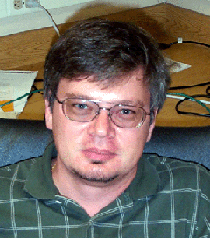
Associate Professor
Department of Cell Biology
Chanin Bldg., Room 414
718.430.4021
dmitry.fyodorov@einsteinmed.org
Research Interest
Recent Publications
Biosketch
|
|
BIOCHEMISTRY AND GENETICS OF CHROMATIN ASSEMBLY
In the eukaryotic nucleus, hundreds of millions of base pairs of DNA are packed into chromosomes. Chromatin, the central nucleoprotein filament of a chromosome, has many different forms and organization levels. Chromatin is the natural state of DNA in the nucleus and the native substrate for nuclear reactions such as DNA replication, recombination, repair and transcription. The assembly of DNA into chromatin and dynamic conversion between its different forms are critical steps in the maintenance and regulation of the eukaryotic genome. The ultimate goal of our research is to understand how chromosomes are assembled and how chromatin assembly regulates the structure and activity of eukaryotic chromosomes. The crucial first step in this direction is a systematic study of factors that mediate this process. To this end we use biochemical approaches to analyze mechanisms of chromatin assembly by histone chaperones and ATP-dependent enzymes. We also dissect their function in vivo by methods of Drosophila genetics. Thus, we are trying to uncover the intricate network of assembly factors and their roles in the hierarchical organization of the chromosome.
1. Molecular mechanisms of nucleosome assembly
ACF (ATP-utilizing chromatin assembly factor) was identified on the basis of its ability to mediate ATP-dependent reconstitution of chromatin in vitro. ACF consists of two subunits, a SNF2-like ATPase ISWI and another evolutionary conserved polypeptide termed Acf1. In the presence of a core histone chaperone NAP-1, ACF/ISWI mediate deposition of histone octamers onto DNA and form arrays of regularly spaced nucleosomes. We study ACF and ISWI as prototype factors to elucidate elementary molecular events that take place during ATP-dependent formation of nucleosomes. Upon reaction initiation, ACF commits to the DNA template and assembles nucleosomes as a processive, ATP-driven, DNA-translocating motor. Multiple conserved domains of Acf1 and ISWI are required for this activity.
2. Biological function of chromatin assembly factors
ACF is the major ATP-dependent chromatin assembly factor in Drosophila. To expose its biological functions, we study fly mutants that do not express ACF. ACF-deficient animals have multiple defects of chromatin organization. However, ACF is not essential for fly viability due to the presence of additional, redundant ACF-like factors. We discovered a novel ISWI-containing complex ToRC (comprising Tou, ISWI and CtBP) that can functionally substitute ACF in vivo. SNF2-like protein CHD1 is another ATP-dependent nucleosome assembly factor. We disrupted Chd1 in flies and discovered that CHD1 is specifically required for replication-independent deposition of histones into chromatin in vivo.
3. Higher-order chromatin forms
ACF can mediate deposition of both core and linker histones (H1) in vitro. Thus, it can assemble the 30 nm chromatin fiber in a defined system. To reconstitute other higher-order chromatin structures, we incorporate modified core histones, histone variants and heterochromatin proteins. In vitro assembled chromatin vectors can turn into useful tools in research and therapy. Among other outcomes, these studies will eventually lead to the discovery of techniques to reconstitute functional metazoan chromosomes. Sperm DNA is compacted with protamines to form enzymatically static sperm “chromatin”. We have begun to analyze protein factors that mediate protamine deposition during spermatogenesis and their removal from DNA after fertilization.
|